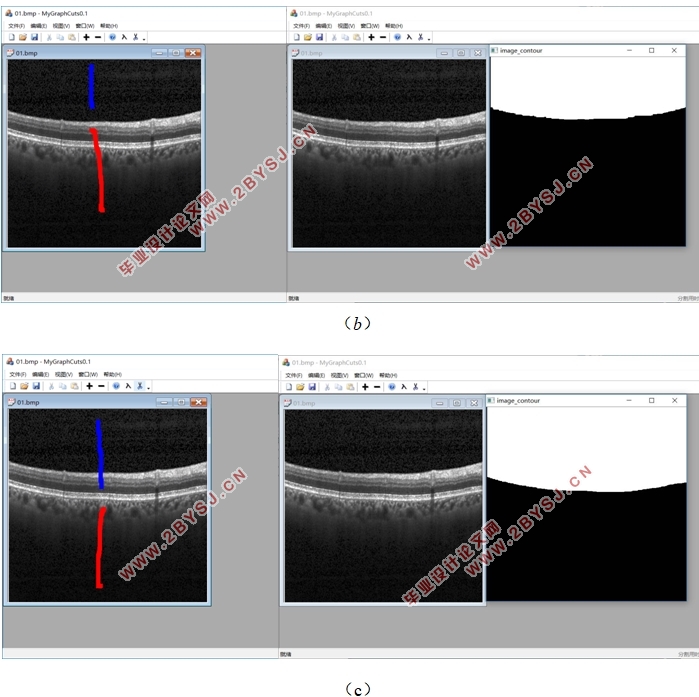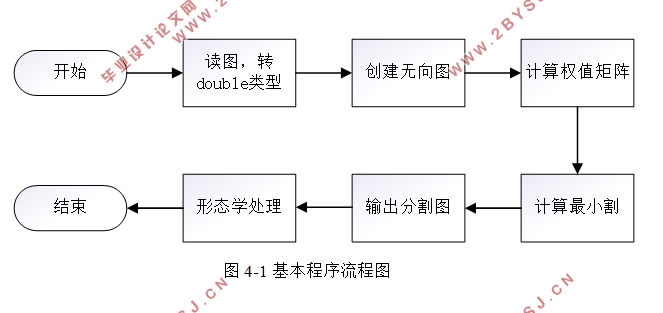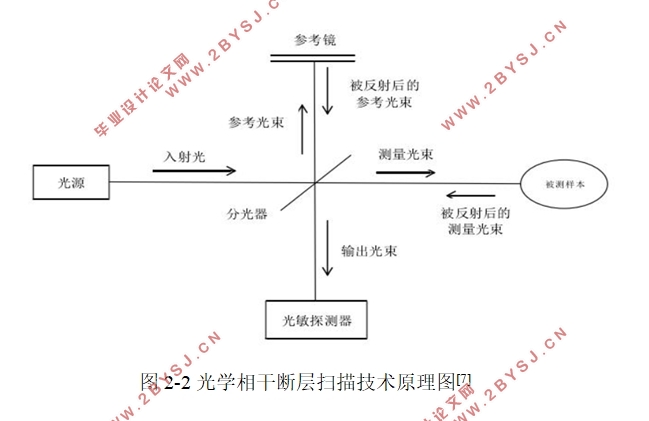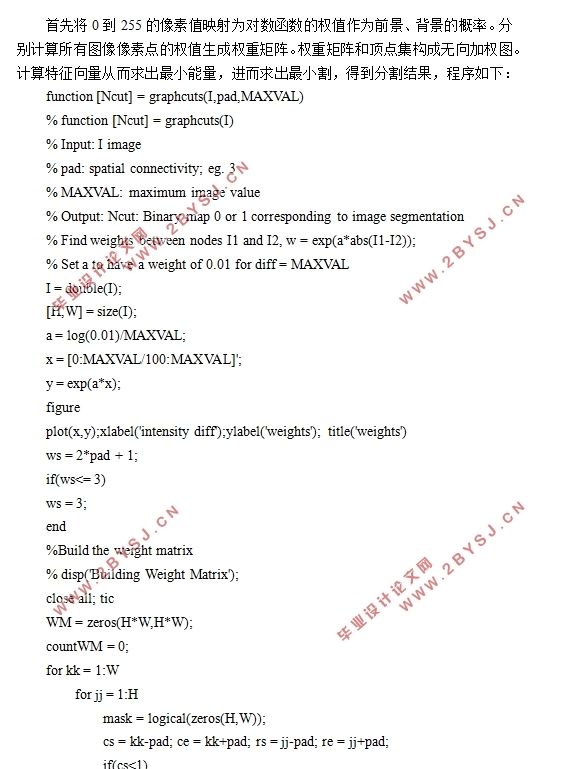OCT眼底图像分割方法研究
无需注册登录,支付后按照提示操作即可获取该资料.
OCT眼底图像分割方法研究(论文13000字,外文翻译,程序代码)
摘 要
通过光学相干断层扫描(Optical Coherence Tomography,OCT)成像技术处理可以将视网膜的层状组织结构进行详细扫描检测,以便获取眼底视网膜各层的形状、厚度等形态结构信息,最终实现对病理特征的变化趋势的可视化。在获取眼底OCT图像基础上,借助计算机辅助诊断(Computer Aided Diagnosis, CAD)技术对图像进行智能化处理,不仅可以在一定程度上提高医生对病情诊断的效率,有效提升病情判断的准确度,甚至还能够达到早期预防、早期诊断和早期治疗的目的。
对眼底OCT图像各组织结构层进行自动化分割是实现计算机辅助诊断的基础。基于能量泛函,以图论为数学基础的图割算法在应用于影像医学领域,对眼底视网膜层状结构的分割就能发挥巨大作用。在图割法中,进行图像分割实际上就是求能量最小化问题。通过构造网格,将该问题转化为求最小割的解,根据最大流最小割原理再将其转化为求解最大流问题。分割时将前景控制点、背景控制点和图像的所有像素点作为无向加权图的各个顶点,把相邻像素点间关系、像素点与控制点归属概率关系等作为无向加权图的边,完成图像到无向加权图的映射。最后把相邻像素间的相似关系设计为权值,由此得出图的能量函数,进行分割。对自动直接分割的图像进行形态学处理,使之能够显示出更加合理的视网膜层状结构。
本研究将经典图割算法应用到眼底OCT图像分割当中,并针对分割结果的不足对算法进行了改进。
关键词:光学相干扫描技术;视网膜层状结构;医学图像处理;图割算法
Abstract
Through optical coherence tomography (OCT) imaging technology, the lamellar structure of the retina can be scanned in detail in order to obtain the morphological and structural information of the retinal layers, such as the shape and thickness of the retina.Finally,visualization of the changing trend of pathological features is realized.On the basis of acquiring fundus OCT images, the intelligent processing of images with computer aided diagnosis (CAD) technology can not only improve doctor's efficiency in diagnosis of diseases, but also effectively improve the accuracy of condition judgment, even it can also achieve early prevention, early diagnosis and early treatment.
Automated segmentation of the OCT image structure layers is the basis for computer-aided diagnosis. Based on the energy functional, the graph-cutting algorithm based on graph theory as the basis of mathematics is applied in the field of imaging medicine, and it can play a significant role in the segmentation of the retinal layered structure of the fundus.In the graph cut method, image segmentation is actually the problem of minimizing energy. By constructing a grid, this problem is transformed into a solution to the minimum cut, and then it is converted into a solution to the maximum flow according to the principle of maximum flow minimum cut.In the segmentation process, different pixels of the image are used as the vertices of the graph, and the relationship between adjacent pixels is used as the edge of the graph to complete the mapping of the image to the weighted graph. Finally, the similarity between adjacent pixels is designed as a weight, and the energy function of the graph is obtained. The morphological processing of the automatically and directly segmented images enables the display of a more rational layered structure of the retina.
In this study, the classical image segmentation algorithm is applied to the segmentation of fundus OCT images, and the algorithm is improved for the lack of segmentation results.
Keywords: Opticalcoherenttechnology; Retinal layered structure;Medical image processing;Graph Cut Algorithm
论文工作及撰写安排
本次课题研究的主要工作是应用基于最大流最小割的图割算法,从能量泛函的角度来对光学相干断层扫描的眼底图像视网膜进行层分割。针对OCT眼底视网膜图像的分割,本文将从以下几个方面展开讨论:首先,查阅光学相干断层扫描技术及图像分割技术、算法的基本内容,了解分割的基本流程。回顾目前国内外影像医学研究和图像分割技术研究,对视网膜分割的技术储备和理论储备有大致了解。通过实验,将OCT眼底视网膜图像利用图割算法完成对视网膜的层分割,以此帮助临床医师对眼科疾病的早期发现和诊断治疗。本文章节撰写安排和整体结构布局如下:
第一章:绪论。首先是介绍影像医学和图像分割技术的发展历程、发展背景,阐述计算机辅助诊断技术在影像医学中的重要作用。简明扼要地介绍了对OCT眼底视网膜图像分层的目的是为了获得精准、高效、可视化图像,其意义是为临床医师提供早期发现和诊治的判断依据。最后简述了视网膜分层技术的国内外研究现状,给出全文结构,让读者清晰本文脉络。
第二章:OCT眼底图像概要。本章首先对光学相干断层扫描技术进行简单介绍,向读者说明人眼视网膜各层结构及其与临床眼科疾病的关系、病理特征等。结合OCT技术阐明眼底视网膜的OCT图像所存在的缺陷并分析其特点。
第三章:图割算法概述。本章简明阐述了图割算法的基本概念、定理等理论知识和算法模型,分析其优劣。
第四章:实验及结果。
第五章:总结与展望。本章概述全文,总结研究结果。回顾眼底视网膜OCT图像的层分割,指出本文存在的不足之处,对可改进的地方进行展望。




目 录
第一章 绪论 1
1.1 课题的研究背景 1
1.1.1 影像医学的发展及研究背景 1
1.1.2 图像分割的发展及研究背景 1
1.2 课题的研究目的和意义 2
1.3 国内外研究现状 3
1.4 论文工作及撰写安排 4
第二章 OCT眼底视网膜图像概述 5
2.1 光学相干断层扫描技术 5
2.1.1 光学相干断层扫描技术简介 5
2.1.2 光学相干断层扫描技术原理 6
2.1.3 光学相干断层扫描技术成像的特点 7
2.1.4 光学相干断层扫描技术的应用 7
2.2 视网膜层次结构 7
2.3 视网膜病症的OCT表现 9
2.4 本章小结 10
第三章图割算法概述 11
3.1 概念及定理 11
3.1.1 图 11
3.1.2 网络流 11
3.1.3 割集 11
3.1.4 最大流最小割定理 12
3.2 图割算法 12
3.3 本章小结 14
第四章实验及结果 15
4.1 图像预处理 15
4.2 程序流程图 15
4.3 图割算法程序 16
4.4实验结果与分析 18
4.5本章小结 22
第五章总结与展望 23
5.1 工作总结 23
5.2 未来展望 23
参考文献 25
附 录 26
外文资料 28
中文翻译 34
致 谢 38
